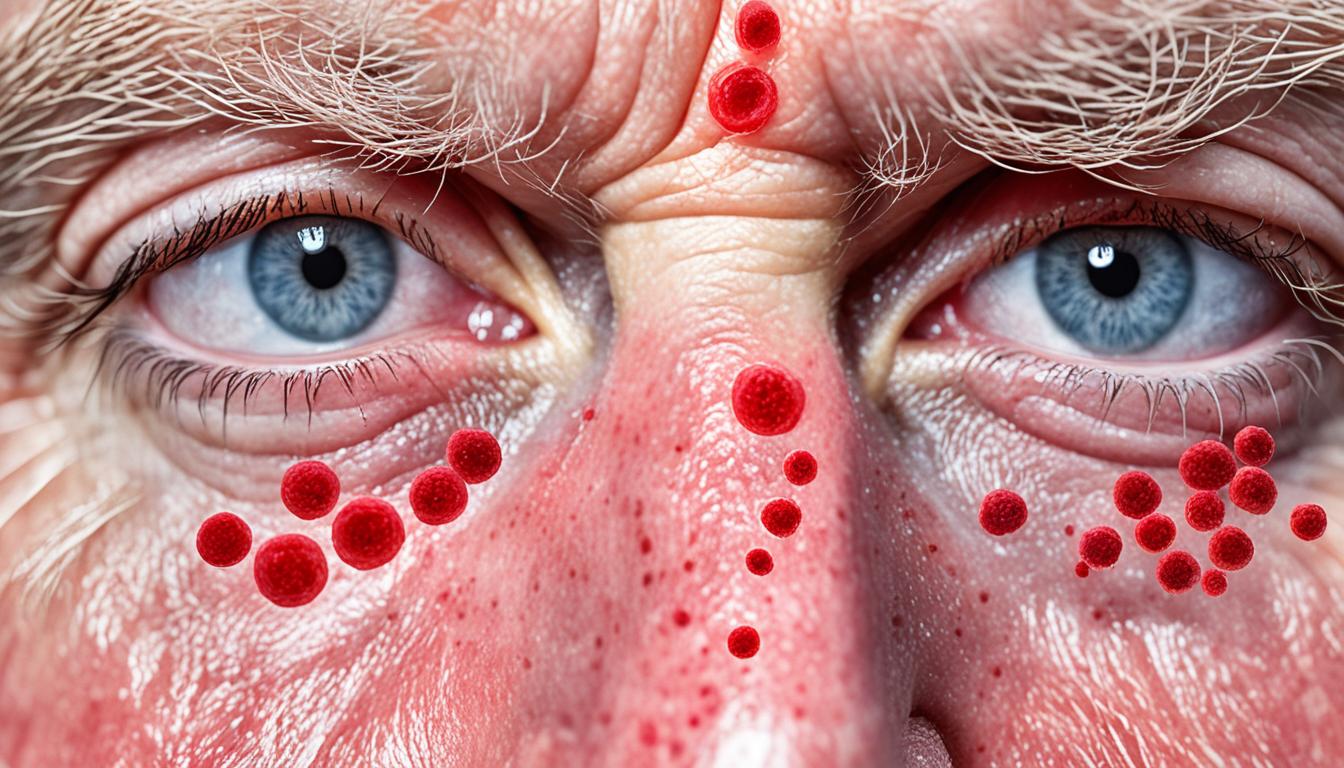Fever blisters, or cold sores, are annoying mouth blisters. They show up mainly on the lips. A virus called herpes simplex type 1 (HSV-1) causes them.
The virus stays quiet in the body but can get active again. This happens due to stress, sickness, or hormonal changes. It’s hard to know what will cause a blister.
Learning about their symptoms and causes helps you be ready for them. New treatments like stem cell therapy might offer a way out.
- Fever blisters, or cold sores, are painful blisters that form in or around the mouth.
- The herpes simplex virus type 1 (HSV-1) is the main cause of fever blisters.
- Triggers for cold sore outbreaks can include stress, illness, hormones, and more.
- Understanding the symptoms and causes of fever blister disease can help prepare for future flare-ups.
- Stem cell therapy is an innovative treatment option being explored for fever blisters.
Symptoms of Fever Blister Disease
Fever blister disease shows up as small and painful blisters near your lips. You may also notice redness, swelling, and feel a tingle or burn. Other signs include mouth pain, fever, a sore throat, neck swelling, and drooling in kids.
Your first fever blister outbreak might be tougher than later ones. These blisters are very easy to spread, so always avoid touching them or their fluid.
Knowing these symptoms is key to getting the right help and stopping the virus. If these signs show up, see a doctor for the right advice and treatment.
Dealing with fever blisters can be both annoying and embarrassing. Luckily, there are lots of ways to make them feel better. You can use creams, antiviral drugs, or try some natural treatments. But remember, these only help with the symptoms; they won’t get rid of the virus.
Next, we’ll dive into what causes and how to diagnose fever blister disease. This info will give you a full view of this condition.
Causes and Diagnosis of Fever Blister Disease
Fever blister disease is caused by a virus called HSV-1. It spreads through direct contact with infected saliva or sores. You can catch it by sharing utensils, kissing, or touching the affected area. Once infected, the virus stays in nerve cells and can come back, causing blisters again and again.
Doctors can often diagnose fever blisters just by looking at them. They also ask about your health to make sure it’s not something else. Sometimes, they do tests to check for the virus. This is especially true if the symptoms are not clear.
Doctors may use the following tests to diagnose fever blister disease:
1. Viral Culture:
A sample is taken from a blister and put in a dish to see if the virus grows. Then, using a microscope, the doctor can tell if it’s HSV-1.
2. Polymerase Chain Reaction (PCR) Test:
This test finds the virus’s DNA, even when it’s not causing symptoms. It’s very good at detecting HSV-1.
3. Blood Tests:
Blood tests can show if your body has made antibodies against HSV-1. These tests tell if you’ve had the virus before and how your immune system is doing.
It’s vital to see a doctor if you think you have a fever blister. Getting checked early and starting treatment can ease symptoms, shorten outbreaks, and stop you from spreading the virus.
| Causes of Fever Blister Disease | Diagnosis of Fever Blister Disease | |
|---|---|---|
|
|
Stem Cell Therapy for Fever Blister Disease
Stem cell therapy is a new way to help those with fever blister disease. It uses the power of stem cells to fix and grow new healthy tissue. This could help lessen how often you get fever blisters and how bad they are.
You can get stem cells from various places, like bone marrow or fat tissue. The process starts by collecting and growing these cells. Then, doctors put them into the area that needs repair. This method is focused on speeding up healing and making fever blisters go away faster.
Even though stem cell therapy is new for fever blister disease, it shows a lot of promise. Scientists are still learning about its effects and if it can help in the long run. This gives hope to those looking for new ways to treat fever blisters.

